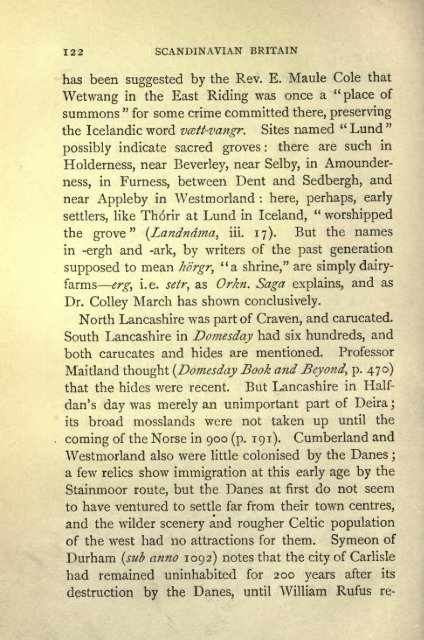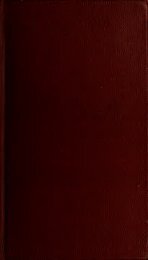- Page 1:
Attainrwiaancse6COCOF-nb ihe late
- Page 4 and 5:
PUBLISHED UNDER THE DIRECTION OF TH
- Page 6 and 7:
PREFATORY NOTEIN the part of this w
- Page 8 and 9:
8 SCANDINAVIAN BRITAINIt will be we
- Page 10 and 11:
10 SCANDINAVIAN BRITAINgeneration b
- Page 12 and 13:
12 SCANDINAVIAN BRITAINII.MOTHER-LA
- Page 14 and 15:
14 SCANDINAVIAN BRITAINover Harold
- Page 16 and 17:
J6SCANDINAVIAN BRITAINwest coast of
- Page 18 and 19:
1 8 SCANDINAVIAN BRITAINfor its chi
- Page 20 and 21:
20 SCANDINAVIAN BRITAINthe peopled
- Page 22 and 23:
22 SCANDINAVIAN BRITAINcited from s
- Page 24 and 25:
24 SCANDINAVIAN BRITAINLet no man t
- Page 26 and 27:
26 SCANDINAVIAN BRITAINfood, and ha
- Page 28 and 29:
28 SCANDINAVIAN BRITAINIII.THE WICK
- Page 30 and 31:
30 SCANDINAVIAN BRITAINsweeps that
- Page 32 and 33:
32 SCANDINAVIAN BRITAINand to its x
- Page 34 and 35:
34 SCANDINAVIAN BRITAINcoast, 1 nee
- Page 36 and 37:
36 SCANDINAVIAN BRITAINmen, one fro
- Page 38 and 39:
38 SCANDINAVIAN BRITAINAnd forthwit
- Page 40 and 41:
40 SCANDINAVIAN BRITAINAnother piec
- Page 42 and 43:
4 2 SCANDINAVIAN BRITAINskill (bein
- Page 44 and 45:
44 SCANDINAVIAN BRITAINChronicle th
- Page 46 and 47:
46 SCANDINAVIAN BRITAIN"droves of t
- Page 48 and 49:
48 SCANDINAVIAN BRITAINGuthorm-^Eth
- Page 50 and 51:
50 SCANDINAVIAN BRITAINsupposed to
- Page 52 and 53:
52 SCANDINAVIAN BRITAINScandinavian
- Page 54 and 55:
54 SCANDINAVIAN BRITAINsimilar expe
- Page 56 and 57:
56 SCANDINAVIAN BRITAINand that the
- Page 58 and 59:
58. SCANDINAVIAN BRITAINplundering
- Page 60 and 61:
60 SCANDINAVIAN BRITAINof the forei
- Page 62 and 63:
62 SCANDINAVIAN BRITAINviking" is a
- Page 64 and 65:
64 SCANDINAVIAN BRITAINand sometime
- Page 66 and 67:
66 SCANDINAVIAN BRITAINnuns :trampl
- Page 68 and 69:
68 SCANDINAVIAN BRITAINnominally un
- Page 70 and 71:
70 SCANDINAVIAN BRITAINfrom the sam
- Page 72 and 73: 72 SCANDINAVIAN BRITAINand the Norw
- Page 74 and 75: 74 SCANDINAVIAN BRITAINheld the sac
- Page 76 and 77: 76 SCANDINAVIAN BRITAINChannel, The
- Page 78 and 79: 78 SCANDINAVIAN BRITAINand Kent ;an
- Page 80 and 81: 80 SCANDINAVIAN BRITAINhave been a
- Page 82 and 83: II.THE DANELAWI. THE AGE OF ALFREDT
- Page 84 and 85: 84 SCANDINAVIAN BRITAINforming a se
- Page 86 and 87: 86 SCANDINAVIAN BRITAINsouthern cam
- Page 88 and 89: 88 SCANDINAVIAN BRITAINIn the sprin
- Page 90 and 91: 90 SCANDINAVIAN BRITAINthen disappe
- Page 92 and 93: 92 SCANDINAVIAN BRITAINfrom Thames
- Page 94 and 95: .Frome94 SCANDINAVIAN BRITAINThorst
- Page 96 and 97: 96 SCANDINAVIAN BRITAINIn May 878 A
- Page 98 and 99: 98 SCANDINAVIAN BRITAINunable to le
- Page 100 and 101: IOOSCANDINAVIAN BRITAINcope with th
- Page 102 and 103: 02SCANDINAVIAN BRITAINthe Danes hel
- Page 104 and 105: 104 SCANDINAVIAN BRITAINand the for
- Page 106 and 107: IO6SCANDINAVIAN BRITAINBucks., and
- Page 108 and 109: Thwaite,108 SCANDINAVIAN BRITAINcon
- Page 110 and 111: 110 SCANDINAVIAN BRITAINtoo loosely
- Page 112 and 113: 112 SCANDINAVIAN BRITAINof the whol
- Page 114 and 115: 114 SCANDINAVIAN BRITAINYorkshire o
- Page 116 and 117: Il6SCANDINAVIAN BRITAINdesignis as
- Page 118 and 119: Il8SCANDINAVIAN BRITAINcounties wer
- Page 120 and 121: 120 SCANDINAVIAN BRITAINthe land wa
- Page 124 and 125: 124 SCANDINAVIAN BRITAIN(now in the
- Page 126 and 127: 126 SCANDINAVIAN BRITAINGuthred's k
- Page 128 and 129: 128 SCANDINAVIAN BRITAINof Irish Vi
- Page 130 and 131: 130 SCANDINAVIAN BRITAINAlban and t
- Page 132 and 133: 132 SCANDINAVIAN BRITAINNorthumberl
- Page 134 and 135: 134 SCANDINAVIAN BRITAINwith a borg
- Page 136 and 137: 136 SCANPINAVIAN BRITAINNot only pe
- Page 138 and 139: 138 SCANDINAVIAN BRITAINYork, and e
- Page 140 and 141: 140 SCANDINAVIAN BRITAINWhen Eadred
- Page 142 and 143: 142 SCANDINAVIAN BRITAINIn the grav
- Page 144 and 145: 144 SCANDINAVIAN BRITAINthe lists o
- Page 146 and 147: 146 SCANDINAVIAN BRITAINEngland and
- Page 148 and 149: 148 SCANDINAVIAN BRITAINsaid to hav
- Page 150 and 151: 150 SCANDINAVIAN BRITAINas the Chro
- Page 152 and 153: 152 SCANDINAVIAN BRITAINthe act of
- Page 154 and 155: 154 SCANDINAVIAN BRITAINnamed Thrym
- Page 156 and 157: 156 SCANDINAVIAN BRITAINwhere Eadmu
- Page 158 and 159: 158 SCANDINAVIAN BRITAINthe canal,
- Page 160 and 161: l6oSCANDINAVIAN BRITAINthe Danelaw,
- Page 162 and 163: 1 62 SCANDINAVIAN BRITAINeight mark
- Page 164 and 165: 164 SCANDINAVIAN BRITAINand Wessex
- Page 166 and 167: 1 66 SCANDINAVIAN BRITAINeleventh c
- Page 168 and 169: 1 68 SCANDINAVIAN BRITAINhalf Danis
- Page 170 and 171: 170 SCANDINAVIAN BRITAINthem south
- Page 172 and 173:
172 SCANDINAVIAN BRITAINNorthumbria
- Page 174 and 175:
174 SCANDINAVIAN BRITAINnot concili
- Page 176 and 177:
176 SCANDINAVIAN BRITAINScandinavia
- Page 178 and 179:
178 SCANDINAVIAN BRITAINmost of the
- Page 180 and 181:
l8oSCANDINAVIAN BRITAINof samples :
- Page 182 and 183:
III.THE NORSE SETTLEMENTSSo far,we
- Page 184 and 185:
184 SCANDINAVIAN BRITAINYorkshire.
- Page 186 and 187:
1 86 SCANDINAVIAN BRITAINthough mix
- Page 188 and 189:
1 88 SCANDINAVIAN BRITAINfrom the O
- Page 190 and 191:
IQOSCANDINAVIAN BRITAINMadoc to att
- Page 192 and 193:
IQ2SCANDINAVIAN BRITAINwasted lands
- Page 194 and 195:
194 SCANDINAVIAN BRITAINthe Anglian
- Page 196 and 197:
196 SCANDINAVIAN BRITAINpastures of
- Page 198 and 199:
198 SCANDINAVIAN BRITAINother than
- Page 200 and 201:
200 SCANDINAVIAN BRITAINCumberland
- Page 202 and 203:
202 SCANDINAVIAN BRITAINin the abse
- Page 204 and 205:
204 SCANDINAVIAN BRITAIN"Cardeu and
- Page 206 and 207:
206 SCANDINAVIAN BRITAINthe monumen
- Page 208 and 209:
208 SCANDINAVIAN BRITAINhad done, a
- Page 210 and 211:
210 SCANDINAVIAN BRITAINitto Malcol
- Page 212 and 213:
212 SCANDINAVIAN BRITAINand Kirkby
- Page 214 and 215:
214 SCANDINAVIAN BRITAINBrisco (Byr
- Page 216 and 217:
2l6SCANDINAVIAN BRITAINWythop was f
- Page 218 and 219:
2l8SCANDINAVIAN BRITAINdomestic lif
- Page 220 and 221:
220 SCANDINAVIAN BRITAINAspatria, P
- Page 222 and 223:
222 SCANDINAVIAN BRITAINGaelic and
- Page 224 and 225:
224 SCANDINAVIAN BRITAINthough not
- Page 226 and 227:
226 SCANDINAVIAN BRITAINdistress. T
- Page 228 and 229:
225 SCANDINAVIAN BRITAINcontinued c
- Page 230 and 231:
230 SCANDINAVIAN BRITAINsubmission
- Page 232 and 233:
232 SCANDINAVIAN BRITAINAt Heysham
- Page 234 and 235:
234 SCANDINAVIAN BRITAINThen follow
- Page 236 and 237:
236 SCANDINAVIAN BRITAINthat the Is
- Page 238 and 239:
SCANDINAVIAN BRltAIN(Lochlan), show
- Page 240 and 241:
240 SCANDINAVIAN BRITAINDiurinis (d
- Page 242 and 243:
242 SCANDINAVIAN BRITAINsubsequent
- Page 244 and 245:
244 SCANDINAVIAN BRITAIN6. THE EARL
- Page 246 and 247:
246 SCANDINAVIAN BRITAINless certai
- Page 248 and 249:
248 SCANDINAVIAN BtUTAlNgave Orkney
- Page 250 and 251:
250 SCANDINAVIAN BRITAINof Havard,
- Page 252 and 253:
252 SCANDINAVIAN BRITAINKendall, th
- Page 254 and 255:
'254 SCANDINAVIAN BRITAINMargaret,
- Page 256 and 257:
256 SCANDINAVIAN BRITAINJohn's son
- Page 258 and 259:
258 SCANDINAVIAN BRITAINwere made a
- Page 260 and 261:
260 SCANDINAVIAN BRITAINare occasio
- Page 262 and 263:
262 SCANDINAVIAN BRITAINGreat Foud,
- Page 264 and 265:
264 SCANDINAVIAN BRITAIN1904). It r
- Page 266 and 267:
266 INDEXBlakari of Dublin, 136, 13
- Page 268 and 269:
268Hasting, 82, 97-99, 125, 192,Gor
- Page 270 and 271:
270 INDEXMoylemurry, 132Muirceartac
- Page 272 and 273:
272 INDEXThingsteads, sites of, 106
- Page 274 and 275:
PUBLICATIONS OF THKTHE HEATHEN WORL
- Page 276 and 277:
^e Staffers for ngltel)Fcap. 8vo, c
- Page 278 and 279:
PUBLICATIONS OF THEpublications.A D
- Page 281:
DA Collingwood, William Gershora158



